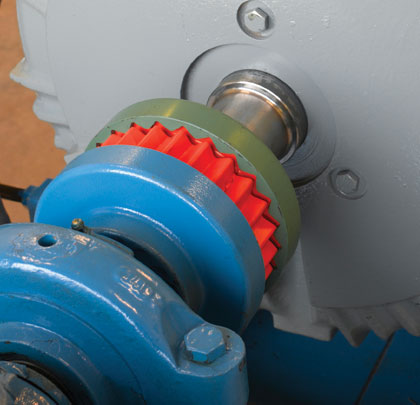For a wide range of applications, disc couplings are the best solution to link a drive or other power source to rotating equipment. Even in the most demanding conditions, disc couplings provide industrial pump users an efficient and exact connection that also forgives a range of minor misalignments incurred by heavy and repeated use.
However, just because a technology is widely used, doesn’t mean that it’s already perfected. In fact, the far-reaching experience pump users have with disc couplings provides a perfect testing ground for experimentation and improvements. If a disc coupling manufacturer has not consciously optimized their products given the possible applications, they may be forced to recommend a heavy, over-engineered coupling in certain situations. Additionally, as disc coupling manufacturers attempt to stretch their product line to meet increasing torque ranges, they inevitably sacrifice strength and durability. Those who select and specify disc couplings should be aware that design durability requirements vary greatly between manufacturers. Rexnord has looked closely at the disc coupling dilemma and believes we have found a solution.
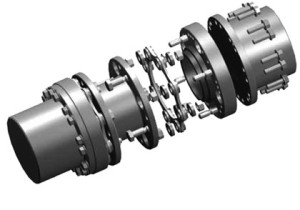
Cutaway for the XTSR71series disc coupling.
MANY OPTIONS AVAILABLE
There are many flexible coupling technologies available. This can be attributed to the fact that there is not a single solution for all applications. Prime examples of this are low power pump and compressor applications where elastomeric designs are typically considered. As the speed and torque of these same applications increase, disc couplings become the industry standard. Disc couplings dominate this segment because of their high torsional stiffness, ability to be accurately balanced, relatively long operating life, low maintenance, and high torque density.
Many products are too conservative in their torque ratings, while others are arguably too aggressive. Those who specify disc couplings should understand that manufacturers of disc couplings must strike a balance between maximizing torque density and durability, and different manufacturers’ disc couplings are not designed to the same durability specifications. Those who specify and maintain disc couplings or manufacture equipment that utilizes disc couplings should be aware of the implications of this tradeoff as they can lead to costly and unsafe coupling selection.
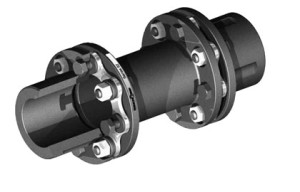
Cutaway for the XTSR52 series disc coupling.
TORQUE DENSITY MATTERS
Historically, manufacturers have offered products with very conservative torque ratings to ensure that the coupling would last a very long time. While this may have given the customer peace of mind, it also resulted in a higher cost and a heavier coupling. While the impact of a higher cost is clear, a heavier coupling’s impact is more subtle. Differences in coupling weight are often seen as negligible; however, a heavier coupling can be more difficult to design around. The heavier weight causes a greater bending moment on the pump or compressor shaft which leads to higher vibration levels, and may even increase wear on the bearings and seals.
By considering the coupling’s torque density, those responsible for specifying disc couplings will avoid selecting an overly conservative coupling and will be closer to choosing the optimal coupling for their application. Torque density can be defined in a number of ways. One is the torque capacity per outside diameter of the assembled coupling. This metric is useful when concerned about the space limitations around the coupling. Another method of defining torque density is the customer application’s continuous torque per unit mass of the coupling. This metric, which is used throughout this paper, is more relevant in the design of high-powered pumps, fans and compressors. Relative to many flexible coupling applications, these can have relatively high speed and torque requirements.
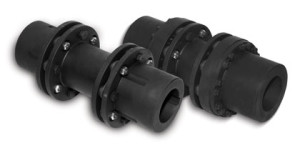
Rexnord recently introduced its new Thomas XTSR52 (left) and XTSR71 (right) Disc Couplings.
TORQUE DENSITY ANALYSIS
The highest torque density coupling meets the application’s torque requirements while minimizing coupling weight, but how confident can the specifier be in the manufacturers’ abilities to properly rate the coupling? The following analysis highlights that some manufacturers aggressively rate their couplings, and their products may not last as long as expected, while others are more conservative for certain applications resulting in a heavier product with potential for accelerated bearing and seal wear.
A simple torque density analysis can be completed using the ratings from a variety of manufacturers’ product catalogs. To demonstrate how this can be accomplished we will compare the torque density of a variety of disc couplings for a standard NEMA motor frame commonly used to drive pumps, fans and some compressors.
While many factors require consideration, basic coupling sizing requires that the coupling can accommodate the required shaft sizes and nominal continuous torque. Figure 1 compares a variety of manufacturers’ disc couplings versus the NEMA 449T frame size with a service factor of 1.5. The figure plots the torque and bore capacities of various coupling models, as well as the shaft diameter and maximum torque for the NEMA motor frame. A selection can be made from this chart by locating the NEMA requirements for these two parameters and choosing a coupling that exceeds them.
This selection will return coupling models from each of the manufacturers that will meet or exceed the requirements, but it is important to then compare other factors prior to selecting a coupling from this group, such as the coupling weight. Figure 2 shows a weight comparison of several manufacturers’ couplings that meet or exceed the torque and bore requirements for a NEMA 449T motor frame. Note that the coupling weights have been normalized to a 7 inch (177.8 millimeter) distance between shaft ends (DBSE) and both hub bores to the corresponding motor shaft diameter. The chart shows that the heaviest coupling for this application is over 45 percent heavier than the lightest. The weight of the coupling can vary significantly and the impact of this additional shaft load should be considered.
As figure 1 and figure 2 show, the couplings on the left will have the highest torque density for these applications because they meet the torque and bore requirements while minimizing weight. Therefore, they are the most efficient designs for this application. While it may not be essential to select the most torque dense coupling from the group, those who specify disc couplings should be aware that a single manufacturer’s best product for a certain application can be much heavier than another manufacturer’s best product.
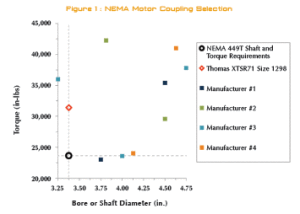
NEMA 449T motor frame shaft and torque requirements (S.F. = 1.5) compared with leading
manufacturers’ coupling torque and bore capacities.
DURABILITY TESTING
Although we often take the catalog torque ratings for granted, it is important to verify that the durability of each of these disc couplings is up to expected levels. Some end users have requested certain durability requirements, or compliance with the DIN-740 coupling specification that calls for the ability to withstand 100,000 load cycles. Even if the end user does not request certain levels of durability, it is good practice for manufacturers to have internal requirements for cycle testing based on system start and stop expectations. Cycle testing was completed on four major brands of disc couplings to compare durability and to understand.
The test stand utilized a hydraulic actuator to rotate a shaft and apply the catalog rated peak torque load to one end of the coupling, while holding the other end of the coupling static. This unidirectional test cycled between zero load and catalog peak torque load for eleven disc coupling samples from four different manufacturers. One load cycle is defined as an applied load of zero to catalog peak torque rating. While many product samples experienced disc pack flaring or buckling at some point in the test, the samples were not deemed a failure until the disc packs had fractured.
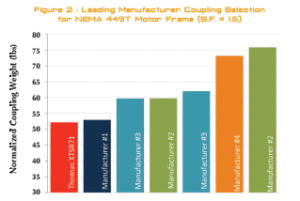
Normalized weight comparison of the couplings.
Figure 3 plots the results of each of the eleven samples tested from four leading disc coupling manufacturers. Note that two manufacturers, Thomas and Manufacturer B, passed all of the samples tested, while the others’ samples failed. The results show that samples from two of the four manufacturers only withstand 50 percent of the start and stop cycles compared with other manufacturers. These findings highlight that regardless of catalog ratings, not all products can withstand the durability requirements referenced by many coupling specifiers.
While selecting a disc coupling does not have to be complicated, it is important to understand the trade-offs that coupling manufacturers make between torque density and durability. It is always prudent to opt for the coupling with the highest torque density to minimize the coupling’s inertia and impact on bearing and seal wear; however, those who specify and maintain disc couplings or manufacture equipment that utilize disc couplings should be aware of the differences in coupling durability between manufacturers. Simply taking the couplings’ catalog ratings for granted without understanding the design criteria used by the manufacturer can result in the selection of an inadequate coupling, particularly for critical applications that require highly durable products.
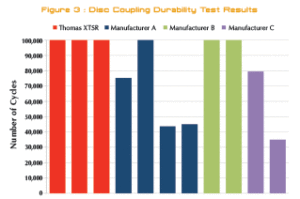
Coupling peak torque cycle test results.
THOMAS® XTSR52 AND XTSR71 DISC COUPLINGS
Advancing the industry’s performance further, Rexnord recently introduced its new Thomas® XTSR52 and XTSR71 disc couplings, an offering with enhanced features that provide customers with the highest value solution for rotating equipment.
“Committed to evolving with customers and their needs, Rexnord has advanced the Thomas series 52 and 71 with the launch of the Thomas XTSR disc coupling offering,” explains Santanu Debnath, director, commercial operations, coupling.
The Thomas XTSR disc couplings are used on rotating equipment in industries such as oil and gas, petrochemical, and power generation. Combining compact size and powerful performance, the Thomas XTSR52 and XTSR71 provide customers with
- Optimization for the industry—the offering features higher torque, lower mass and an all-metric design.
- Simple installation and maintenance—the combination of modular components, ability to retrofit to Thomas and John Crane Metastream hubs, tapered bolts, unitized disc pack, integrated balancing hardware, and clear product markings, allow for ease of installation and maintenance.
- Strengthened operation and safety—multiple features, including an anti-flail ring, overload bushings, standard manganese phosphate coating and optional torque overload protection system provide increased equipment operating safety.
“We continually seek out customer needs and find ways to add value to the Rexnord coupling product line that our customers demand, and this new design has helped us achieve that,” explains Michael Skowronek, director, global portfolio management, bearings and global coupling. ■
_________________________________________________________________________
ABOUT THE AUTHOR
Charlie Kopplin is a global product manager for Rexnord, and Todd Schatzka is a staff engineer for the Rexnord Innovation Center. Headquartered in Milwaukee, Wisconsin, Rexnord is a leading worldwide industrial company comprised of two strategic platforms: Process and Motion Control and Water Management. For more information, visit www.rexnord.com.
_________________________________________________________________________
MODERN PUMPING TODAY, July 2013
Did you enjoy this article?
Subscribe to the FREE Digital Edition of Modern Pumping Today Magazine!
![]()


